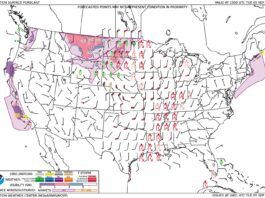Bully for the Kids Up Front
I was having fun despite it being a slog on the airlines. Id spun a cancelation of my flight to La Guardia (due to a tropical storm shutting down the East Coast) into a direct flight home from Toronto to Portland. Circumstance even got me into an airport members-only lounge with cozy couches and free food while I got some work done on the laptop.
Blind to the Ice
It was late afternoon and time to fly home after a productive business meeting. Before heading to the airport, the pilot called Flight Service. Most of the significant weather was along a cold front just to the north of his east-west proposed route. The briefer mentioned some light snow showers were showing up on radar near the front. There were a few pilot reports of light to moderate icing, but all of them were associated with the weather to the north. The briefer alerted the pilot to an AIRMET for IFR conditions and mountain obscuration along a portion of his proposed route, but as of yet no en route advisories for structural icing had been issued.
Talk to me, baby
Ive come to believe that single-pilot IFR in a fully loaded, glass-cockpit-but without using an autopilot-can be the toughest IFR flying you can do. The past month has found me in the clouds with and without students in a couple different airframes that I hadnt recently flown. Thats important because I wasnt in the groove with known power settings and trim. Theres more load on the scan when the plane is less familiar and thats where glass shows its biggest weakness: Visual channel overload.
Readback: December 2010
I thoroughly enjoy your IFR magazine and eagerly look for it every month. I do have a concern about the front-page caption, Bitch-slapped by physics, found on the cover of the October 2010 issue. Come on, Jeff. All of you at IFR magazine are excellent writers who know how to get the information out in a comprehensible form and fashion that is entertaining and useful. Using that description for your article about V-speeds is inappropriate.
Hail in Clear Air
Our flight from Potomac Airfield in Friendly, Md.. to Dublin, Va., (to pick up a new puppy) would take about an hour and a quarter, despite steady headwinds paralleling the Blue Ridge mountains. The only minor wrinkle came from two small cells approximately 10 miles north of our destination. The cells were staggered, traveling west to east across our route at 27 knots, with tops at 43,000 feet and 28,000 feet, respectively.
Weather in the Tropics
Excitement is in the air. We just left Fort Pierce, Florida. Rather than heading to a tame destination like Key West, were pointed southeast-open ocean ahead. Our friend Dave, a constant source of bizarre travel ideas, suggested we visit Pig Beach. Wild pigs supposedly enjoy this spot in the Bahamas, living a life of swimming, sun tanning, and getting dinner from passing tourists.
Radar Revealed
Twenty years ago, the idea of carrying sophisticated digital radar in anything under a medium twin would probably have been met with roars of laughter, but technology has brought amazing advances. Now its possible for even an ultralight pilot to use the Internet to access essentially the same tools that are available to forecasters.
Stratus for ipad ADS-B
ADS-B weather for the iPad has been around for a while, but this is the first year pilots get some real choices. Baron released its Mobile Link with XM weather for the iPad. SkyRadar, which puts ADS-B weather into WingX on the iPad, just released a new device. FreeFlight Systems is promising an in-panel, complete ADS-B solution (traffic and weather) that will wirelessly send data to the iPad.
The Hail detector
Unless you are a weather geek, you probably have never heard of vertically integrated liquid (VIL). VIL is one of dozens of products generated by the same NWS radars that give us composite- and base-reflectivity images weve all come to know and love. Taking a peek at VIL wont revolutionize your use of NEXRAD, but it could warn you which cells are most likely to kick your butt.
Spring Icing surprise
My first winter of cargo flying meant dealing with ice every night. With spring came a sigh of relief that I could finally relax a bit. Boy was that wrong. Instead, I learned that although the temperatures may be warming up, the threat of icing remains throughout much of spring.
Predicting Future IFR
Sometimes the standard forecasts just arent enough. The area forecast (FA) and terminal forecasts (TAFs) are fine for anticipating the weather for the next day or so, but they simply dont extend out far enough in the future to tell you if IFR conditions might mess with your plans three days down the road.
Not believing your eyes
Whats the worst that should happen if that wide runway seems further away? Well, you could end up too high and go around or you could simply land long, risking an overrun. Embarrassing, to be sure, possibly with expensive damage, but seldom much worse than that.

















